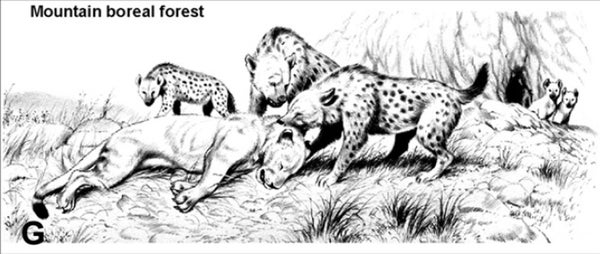This article was published in Scientific American’s former blog network and reflects the views of the author, not necessarily those of Scientific American
The bad blood between lions and spotted hyenas runs deep. Natural history documentaries like Beverly and Derek Joubert’s classic Eternal Enemies have memorialized the conflict, making the gory competition for carcasses a staple of basic cable animal drama. And while calling these carnivores eternal enemies is a bit of an overstatement – the competition between the predators has only existed as long as both have been around – fossil evidence from prehistoric Europe at least partially documents how far back lions and hyenas have been snarling at each other.
Not so far into the past, during the days of the Late Pleistocene prior to 12,000 years ago, both lions and hyenas lived in Europe. Paleontologists have known this for over two centuries. The British naturalist William Buckland made a name for himself in academic circles by teasing out the secrets of hyena-chewed bones found in Kirkdale Cave, and in 1810 the German paleontologist Georg August Goldfuss initially described the cave lion Panthera spelaea. (We now know that this name is a little misleading. The lion sometimes occupied caves, but more often tread across the dry grasslands and through the boreal forests of Eurasia and has been recast as the steppe lion.) The confrontations which take place on the savanna of Botswana today used to be played out on the cool steppe of Germany by slightly different lion and hyena species, highlighting in a 2011 study by paleontologist Cajus Diedrich.
Between 1958 and 1976 a cache of about 4,000 Ice Age mammal bones was excavated along a stretch of the Emscher River near Bottrop in west-central Germany. This collection of 37,000 year old bones has a violent story to tell. Bite marks and other damage to many of the bones has led Diedrich to conclude that the area was a place where hyenas violently dismantled the carcasses of their prey and raised their cubs, shouldering for steppe lions for space.
On supporting science journalism
If you're enjoying this article, consider supporting our award-winning journalism by subscribing. By purchasing a subscription you are helping to ensure the future of impactful stories about the discoveries and ideas shaping our world today.
There are two lines of evidence that place lions at the Bottrop-Wellheim site in northwest Germany. There are bones of the animals themselves, but there's also a rare trackway presenting the pugmarks of a prehistoric lion. The roughly 40-foo-long track slab contains 29 footprints left by an adult steppe lion – 12 of which are forefoot and hindfoot sets – and, since tracks are given their own genus and species names to help organize track types, Diedrich gave this track type the name Pantheraichnus bottropensis.

Hyenas taking over a lion den in the forests of Ice Age Europe. Credit: G. Techmann, Diedrich 2011
The lion tracks are impressive, but the distinctive evidence of the lion’s antagonistic encounters with hyenas is to be found in the bones of the big cats scattered through Bottrop and other sites in northern Germany. “An increasing number of lions remains, including partial skeletons," Diedrich wrote, are being recognized from late Pleistocene hyena den sites in Central Europe.” Many of these bones were chewed on by the ancient cave hyena, Crocuta spelaea. There are lion skulls with portions cracked off, lower jaws marked by the same pattern of breakage, and nibbled limb bones, all of which match up with the standard way that hyenas tend to break down bodies, be they horse, rhino, or lion.
But why are many damaged lion bones found in association with supposed hyena den sites? Diedrich proposes that the lions were killed in fights with hyenas over carcasses or den sites, and, loathe to let fresh meat go to waste, the hyenas dismembered the lion bodies and carried the fresh felid cuts back to their dens. Whether these deadly confrontations were just like those seen in Africa today is unclear - recent research on cave hyena brains suggests that they may not have been as social as today's spotted hyenas. Not to mention that hyenas are consummate scavengers and may have made the most of lions that died for other reasons.
Whatever played out when Ice Age lions and hyenas met each other, however, the hyenas ended up helping paleontologists. They destroyed many bones, surely, but they also added to the fossil record by inadvertently transporting skeletal bits and pieces to places where they had a better chance at preservation. Hyenas helped make the fossil record, preserving the story of their long-running rivals.
References:
Diedrich, C. 2011. Late Pleistocene steppe lion Panthera leo spelaea (Goldfuss, 1810) footprints and bone records from open air sites in northern Germany – Evidence of hyena-lion antagonism and scavenging in Europe. Quaternary Science Reviews. doi: 10.1016/j.quascirev.2011.03.006
[This post was originally published at Wired.]